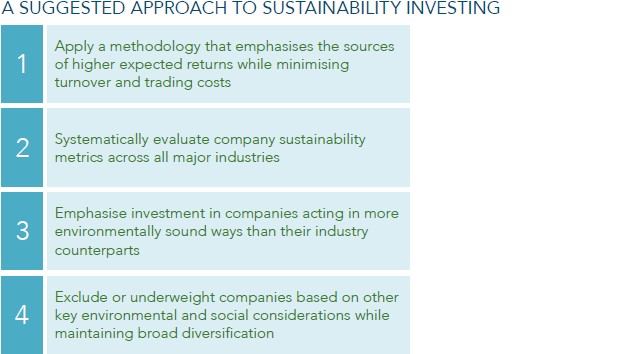Growing interest in the impact of fossil fuels on the global climate often sparks questions from people about whether they can integrate their values around sustainability with their investment goals and, if so, how.
According to a global sustainable investment group that covers Australia, New Zealand and other developed nations, assets managed under ‘responsible investment’ strategies increased by 25% between 2014-16 to $US22.89 trillion.1
Responsible investment is defined by the UN as an approach that aims to incorporate investors’ preferences around environmental, social and governance (ESG) factors into their investment portfolios.
As citizens, individuals can express their political preferences around sustainability through the ballot box. As investors, they also can express their preferences through participation in global capital markets.
The key question is how to do that without compromising their desired investment outcomes. For instance, how can they reduce their portfolios’ carbon footprint while maintaining sufficient diversification and their investment objectives?
And remember, sustainability preferences are not restricted to greenhouse gas emissions. Many people also have concerns about land use and biodiversity, toxic spills, operational waste and waste management.
Furthermore, many investors want to exclude companies strongly associated with undesirable social issues such as tobacco, alcohol, gambling, pornography, child labour, factory farming, nuclear weapons, and cluster munitions and landmines.
So there’s a challenge in achieving the dual goal of efficiently taking into account sustainability and social considerations while building robust investment solutions aimed at growing savings for future consumption.
A solution is to focus first on developing an investment methodology that emphasises the sources of higher expected returns while minimising turnover and trading costs. Once this framework is in place, we can get to work on the other part.
That second phase starts with evaluating companies on a broad array of sustainability measures across all industries. That means looking at companies across the whole portfolio and within individual sectors, with a view to both incorporating sustainability preferences while maintaining as much of the characteristics of the original strategy as possible.
Specifically, the worst carbon polluters across all industries are possibly then kicked out of the portfolio altogether.
Within each industry, the least sustainable companies could be excluded, while the rest are overweighted or underweighted based on how well they rank among their industry peers. By using this scoring system, rather than an in-or-out screening process, we can preserve diversification while encouraging good behaviour.

Taking this combined industry and portfolio approach allows for a dramatic reduction in carbon emissions–an important goal for investors–while maintaining diversification and the focus on the drivers of expected returns.
With social screens, we can take more of a black-and-white approach. So companies that draw a significant proportion of their revenues from tobacco, gambling or one of the other proscribed activities can be excluded altogether.
Importantly, this process of screening and exclusions can be applied to the fixed interest component of a portfolio as well as to the equity component. The principles and the approach are broadly the same.
A further consideration for investors in Australia and New Zealand is to be mindful of the impact of sustainability and social screens in markets that are already, by global standards, small and highly concentrated.
For instance, excluding carbon-intensive energy, materials and utility stocks from an Australian equities portfolio over the 28 years from 1990 would have led to a portfolio that looked significantly different to the market at times.
This ‘tracking error’ can be ameliorated by taking a global approach to sustainability. In other words, the less your bias to domestic equities, the less likely you are of straying a long way from the index; more importantly, the less your home bias, the greater your portfolio’s reduction in emissions.
The key point to take away is that investing well and sticking to your values around sustainability need not be incompatible concepts. But as always you have to take a systematic approach, observing the principles of diversification and targeting the sources of higher expected return.
Whoever said it’s not easy being green?
1. 2016 Global Sustainable Investment Review, Global Sustainable Investment Alliance
